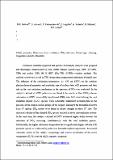Por favor, use este identificador para citar o enlazar a este item:
http://hdl.handle.net/10261/95837COMPARTIR / EXPORTAR:
 SHARE SHARE
 CORE
BASE CORE
BASE
|
|
| Visualizar otros formatos: MARC | Dublin Core | RDF | ORE | MODS | METS | DIDL | DATACITE | |

| Título: | Influence of the surface potassium species in Fe-K/Al2O3 catalysts on the soot oxidation activity in the presence of NOx |
Autor: | Gálvez Parruca, María Elena CSIC ORCID; Ascaso Malo, Sonia CSIC ORCID; Stelmachowski, P.; Legutko, P.; Kotarba, A.; Moliner Álvarez, Rafael CSIC ORCID; Lázaro Elorri, María Jesús CSIC ORCID | Palabras clave: | Alkali promoters Soot oxidation NOx reduction Exhaust-gas cleaning Supported catalysts |
Fecha de publicación: | 27-ene-2014 | Editor: | Elsevier | Citación: | Applied Catalysis B: Environmental 152-153: 88-98 (2014) | Resumen: | Cordierite monolith-supported and powder Fe-K/Al2O3 catalysts were prepared and thoroughly characterized by bulk (XRD, Raman spectroscopy, XRF, ICP-OES, TPR) and surface (XPS, IR, N2-BET, NOx-TPD, K-TPD) sensitive methods. The catalytic activity was tested in TPO (temperature programmed oxidation) of model soot. The influence of the calcination temperature, i.e. 450 and 650°C, on the catalysts physicochemical properties and reactivity, type of surface states of K promoter and their role in the soot oxidation mechanism in the presence of NOx was evaluated. In the catalysts calcined at 450°C potassium was found to be mostly as free KNO3 whereas calcination at 650°C successfully transformed KNO3 into K2O, which during the soot oxidation yielded K2CO3 species. Such carbonates underwent decomposition in the presence of the oxygen surface groups of the support, leading to the formation of active basic O2- groups. NOx species were found to adsorb strongly on these O2- sites. The increased stability of thus formed NOx-species resulted in lower soot oxidation activity. In the same time, the catalysts calcined at 650°C evidenced higher ability towards the reduction of NOx, occurring simultaneously with the soot oxidation process. Additionally, the higher calcination temperature led to significantly higher stability of K promoter species as evidenced by potassium thermodesorption experiments. An overall schematic model of the catalyst morphology and relative distribution of the active components (K, Fe) over the Al2O3 support is proposed. © 2014 Elsevier B.V. | Descripción: | 11 pag., 15 figures, 4 tables. | Versión del editor: | http://dx.doi.org/10.1016/j.apcatb.2014.01.041 | URI: | http://hdl.handle.net/10261/95837 | DOI: | 10.1016/j.apcatb.2014.01.041 | Identificadores: | issn: 0926-3373 |
| Aparece en las colecciones: | (ICB) Artículos |
Ficheros en este ítem:
| Fichero | Descripción | Tamaño | Formato | |
|---|---|---|---|---|
| Influence_of_the_surface_potassium..pdf | 907,76 kB | Adobe PDF |  Visualizar/Abrir |
CORE Recommender
SCOPUSTM
Citations
87
checked on 08-may-2024
WEB OF SCIENCETM
Citations
82
checked on 29-feb-2024
Page view(s)
435
checked on 13-may-2024
Download(s)
478
checked on 13-may-2024
Google ScholarTM
Check
Altmetric
Altmetric
NOTA: Los ítems de Digital.CSIC están protegidos por copyright, con todos los derechos reservados, a menos que se indique lo contrario.
